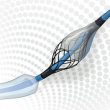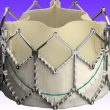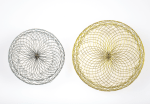Bicuspid aortic valve stenosis (BAV) has not yet been analyzed in large, randomized studies, and TAVR in this scenario has been assessed only by small fairly studies. However, the information available is quite promising. TAVR in women generally presents more complications than in men, but severe bicuspid aortic valve stenosis receiving TAVR has not been...
Balloon expandable vs Self-Expanding Valves: The Best Option for ViV-TAVR in Small Annuli
TAVR has consolidated as an increasingly valid alternative to treat failed surgical aortic valve bioprostheses. One of the major challenges it presents is patients with small annuli treated with a surgical bioprosthesis. There is little data available about this scenario. A few observational studies have shown what appears to be a hemodynamic advantage of...
Surgical Bioprosthesis Deterioration: Is the Valve-in-Valve Technique a Good Option?
The use of surgical bioprostheses has significantly increased, and while they last 15 years or more, in cases where they fail (usually due to stenosis), the decision-making process is challenging. Transcatheter aortic valve replacement (TAVR) is a good alternative for this situation, although information on the subject matter is still scarce. Currently, the only available...
Left Atrial Appendage Closure Is Safe with the New Devices
Left atrial appendage closure (LAAC) in non-valvular atrial fibrillation with high risk of bleeding has shown promising results with first generation devices (with the Watchman) in the different studies. At present, we have a more modern device, the Watchman FLX, but we do not have much information about it. To gather more data, researchers looked...
MitraClip in Patients with COPD: a Valid Option
Chronic obstructive pulmonary disease (COPD) and cardiovascular disease are associated to hospitalization and mortality. When associated to severe mitral regurgitation, not only do these two conditions have poor evolution, but they also limit the possibility of surgical valve replacement, given its high risk. Edge-to-edge repair with MitraClip has been shown beneficial in a group of...
Combination of Percutaneous Suture Devices after TAVR to Reduce Vascular Complications
Current use of transcatheter aortic valve replacement (TAVR) has increased in intermediate-risk patients and has even been used in low-risk patients. Vascular access-related complications and bleeding are still frequent after transfemoral TAVR, being associated with poor short- and long-term outcomes. Using percutaneous closure devices has allowed operators to close the access site without surgery. The...
Non-Cardiac Surgery After TAVR Is Safe
There are increasingly more patients who have undergone transcatheter aortic valve replacement (TAVR) and require a non-cardiac intervention, or patients with other diseases who need surgery and are diagnosed with aortic stenosis. In addition, on many occasions, surgery must be performed as soon as possible (as in cases of cancer) or is an emergency procedure....
SOLACI-SOCIME 2022 | Practical demonstration of aortic valve implantation on native valve. STEP BY STEP
Read the most outstanding articles from the first day of the SOLACI-SOCIME 2022 Congress. In this case, consult the presentation by Dr. Alejandro Alcocer, entitled “Practical demonstration of aortic valve implantation on native valve. STEP BY STEP”
Are Elevated Lipoprotein (a) Levels Associated with Increased Adverse Events After Peripheral Endovascular Treatment?
Peripheral arterial disease is a manifestation of systemic atherosclerotic disease with increasing prevalence. Moreover, this disease is associated with a high risk of mortality and cardiovascular events. Lipoprotein (a) (Lp a)—which has a proatherogenic, proinflammatory, and antifibrinolytic role—has been shown to be related to major cardiovascular events and peripheral vascular events after acute coronary syndromes...
Coronary Physiology Is Useful in Chronic Kidney Disease
Coronary physiology, FFR and iFR, has been shown safe to defer lesions and effective to save stents by different randomized studies and registries. However, patients with chronic kidney disease have not been thoroughly analyzed yet, which brings us to the question about what to do in the face of their negative evolution, when atherosclerosis develops...









